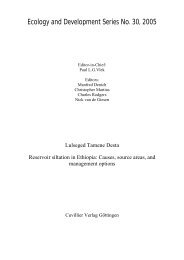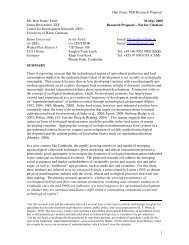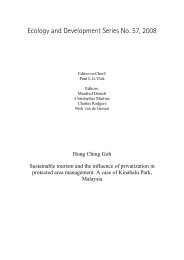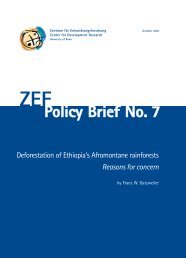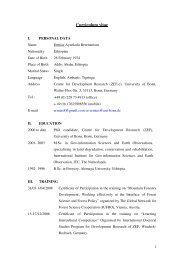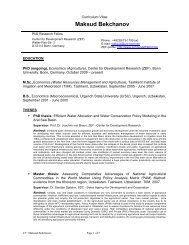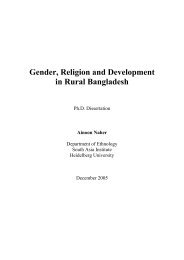Ecology and Development Series No. 10, 2003 - ZEF
Ecology and Development Series No. 10, 2003 - ZEF
Ecology and Development Series No. 10, 2003 - ZEF
- No tags were found...
You also want an ePaper? Increase the reach of your titles
YUMPU automatically turns print PDFs into web optimized ePapers that Google loves.
Floristic analysis of the undisturbed forestGroup 3 comprises 13 plots; 13 species are associated with this group. It has threeindicator species with significant indicator values, namely: Draceana fragrans, Tecleanoblis, <strong>and</strong> Phoenix reclinata (Table 4.2). The common tree species in the canopy layer are:Albizia gr<strong>and</strong>ibracteata, Anthiaris toxicaria, Diospyros abyssinica, Morus mesozygia, <strong>and</strong>Trilepisium madagascariense, while the common tree species in the middle storey areCanthium giordanii, Olea capensis ssp. hochstetteri, Phoenix reclinata, Ritchiea albersii,Teclea noblis <strong>and</strong> Vepris dainelli. The common species in the lower storey areArgomuellera macrophylla <strong>and</strong> Dracaena fragrans; the common climber species in thisgroup are Combretum paniculatum, L<strong>and</strong>olphia buchananii <strong>and</strong> Tiliachora troupinii. Likethe other two groups, this group also has many Afromontane endemic <strong>and</strong> near-endemicspecies (e.g., Albizia gr<strong>and</strong>ibracteata, Olea capensis ssp. hochstetteri, Teclea noblis, <strong>and</strong>Vepris dainelli), <strong>and</strong> the Guineo-Congolian forest species (e.g., Argomuellera macrophylla,Anthiaris toxicaria, Diospyros abyssinica, Dracaena fragrans Morus mesozygia, <strong>and</strong>Trilepisium madagascariense).4.3.3 OrdinationOrdination was performed using PCA (Ter Braak <strong>and</strong> Šmilauer 1998). The results of thePCA ordination are presented in Figure 4.2, Tables 4.4 <strong>and</strong> 4.5. The first four PCA axesexplain 81.1% of the variation in species data, with the first two axes accounting for 64.1%of the variation (Table 4.4).Table 4.3. Percentage variance explained by the first four PCA axesAxis I II III IV TotalvarianceEigenvalues 0.408 0.233 0.111 0.058 1Cumulative % variance of species data 40.8 64.1 75.3 81.1Total eigenvalues 1The distribution pattern of most species in the species-plots biplot was denselyconcentrated around the center of the ordination space where the two axes cross each other.For clarity, only the indicator species for the community types were shown in the biplot(Figure 4.2). A list of the plant species with an absolute value species score greater than or52





